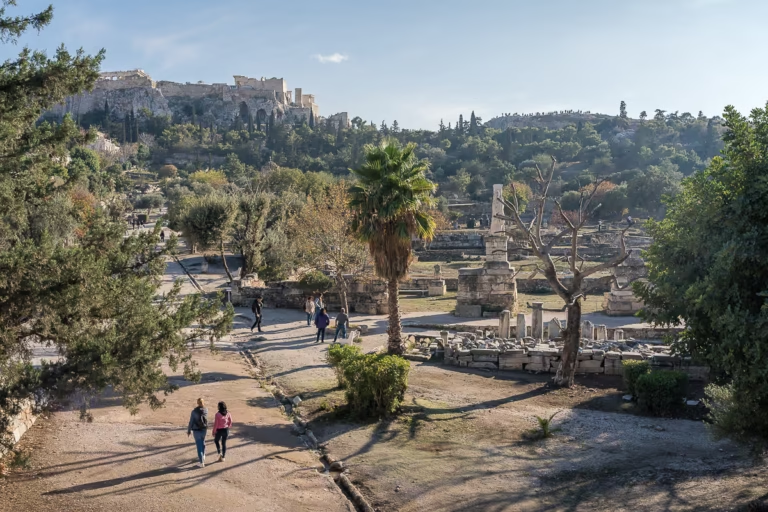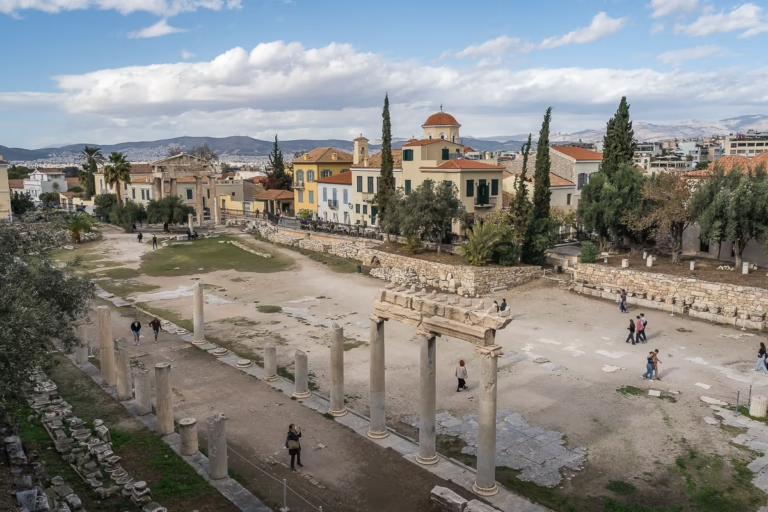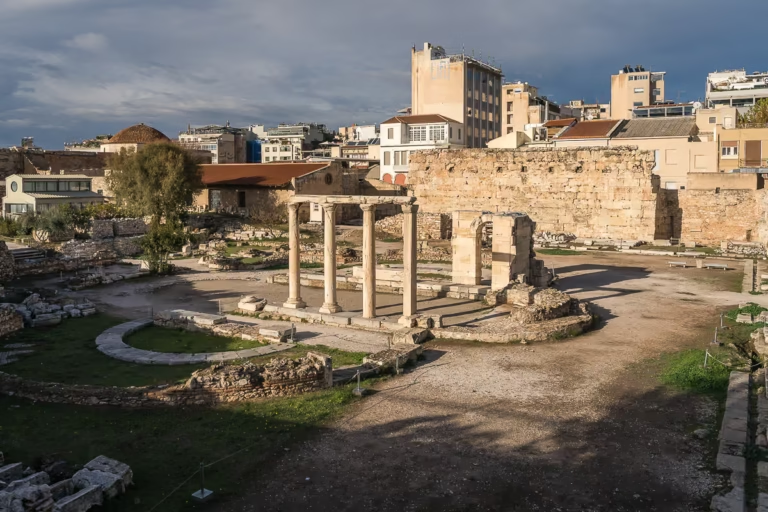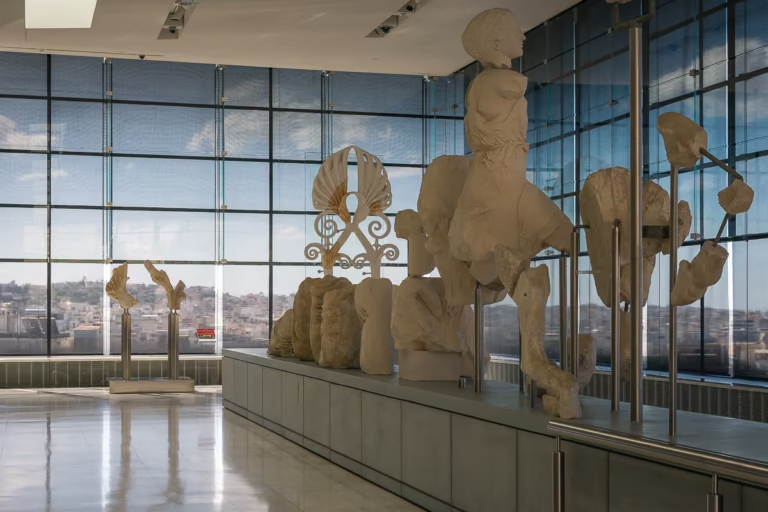Athens Temple of Olympian Zeus & Hadrian’s Arch Guide
This article contains affiliate links that may earn us a commission at no extra cost to you. Read our Affiliate Disclosure for more. Thanks for your support!
A pleasant stroll from Syntagma Square, the Athens Temple of Olympian Zeus or Olympieion is one of the most interesting and easiest-to-visit archaeological sites in the Greek capital.
Home to two iconic landmarks, the remains of the Temple dedicated to Olympian Zeus and the magnificent Hadrian’s Arch or Hadrian’s Gate – which, technically, isn’t part of the archaeological site – the Athens Olympieion should definitely be on any Greek history buff’s list.
Keep reading to find out how to visit the Athens Temple of Olympian Zeus and Hadrian’s Arch.

Where Is The Temple of Olympian Zeus in Athens?
Located in the heart of Athens, the Temple of Olympian Zeus is a short walk from Syntagma Square. The archaeological site’s entrance is on Vasilissis Olgas Avenue, near the National Garden and the neighborhood of Plaka.
Timeline of The Athens Temple of Olympian Zeus
It was in 515 BC, the time of Pisistratus, grandson of Tyrant Pisistratus, when the enormous Temple started being constructed in the Doric style.
In 508 BC, when Cleisthenes established democracy in Athens, construction works stopped. Buildings to serve democracy, like the ones you’ll see if you visit the Ancient Agora of Athens, had to be constructed urgently, abandoning plans for religious sites.

After the Persian Wars in 480-479 BC, the prominent Athenian politician Themistocles hastily built a defensive wall to protect Ancient Athens from both the Persians and the Spartans.
The Themistoclean Wall, as it was called, was of top priority. Therefore, fragments from the Temple of Olympian Zeus were used as building materials for the construction of this fortification wall.
Over the next centuries, the construction of the Temple of Olympian Zeus would stop and restart several times until 131-132 AD, when the Roman Emperor Hadrian finally completed the immense project.
Constructed in the Corinthian style at the end, the Temple of Olympian Zeus started to decay from the 5th century AD onwards.
The original Temple had 104 columns made of Pentelic marble, 16 of which survived the relentless passing of time. One of the 16 surviving columns fell on the ground due to a storm in 1852. It now looks like sliced salami on a platter.

Why Is The Temple of Olympian Zeus Important?
The Temple of Olympian Zeus was the largest temple in Ancient Greece. Dedicated to Zeus, the King of the Olympian Gods, the grand Temple symbolized the city’s strong bonds with the gods.
Built in honor of a secular ruler this time, Hadrian’s Gate carried equally powerful symbolism. It stood at the point where the Ancient Greek city met the Roman city, serving as a visual reminder of everything Hadrian did for the cultural advancement of Athens.

Is The Temple of Olympian Zeus Worth Visiting?
The archaeological site of Olympieion doesn’t have adequate informative signage, while its centerpiece, the imposing Ancient Temple, is currently partially covered in scaffolding. However, it’s still worth a visit for its unique setting.
Its wide open space allows you to take in panoramic views of some of the most emblematic landmarks in Athens, such as the Acropolis and Lycabettus Hill. Moreover, the size of the colossal columns gives you an idea of the splendor of these ancient constructions.

The Myth Behind The Sanctuary of Olympian Zeus
Before the construction of the massive Temple, a sanctuary dedicated to Olympian Zeus was in the same place. According to Greek Mythology, after surviving a catastrophic flood, Deucalion erected the sanctuary as a gift to honor Zeus.
The Deluge of Deucalion is the ancient Greek version of flood myths present in other civilizations and eras, including the Great Flood of Noah.
The Deucalion version narrates that, appalled by humans, Zeus decided to destroy them by causing a cataclysmic flood. Tipped by his father, Prometheus, for the upcoming devastation, Deucalion constructed a boat to get on board with his wife, Pyrrha.

When the devastating floods stopped, Deukalion and Pyrrha were the only human beings to survive. Their boat landed atop Parnassos Mountain. After giving thanks to Zeus, they consulted an oracle to find out how to repopulate Earth.
Deucalion and Pyrrha threw stones behind their shoulders. Stones thrown by Deucalion transformed into men while those thrown by Pyrrha turned into women. The first stone was transformed into a man called Ellinas, which is the Greek word for Greek man.
It’s said that there was a tomb on the grounds of the Athens Olympieion where Deucalion was buried.
FAQs About Visiting The Athens Olympieion
How long does it take to visit the Temple of Olympian Zeus?
It takes between 45 minutes and one hour to walk around the entire archaeological site of Olympieion, including Hadrian’s Gate.
Is the Athens Temple of Olympian Zeus accessible?
Yes, the Olympieion archaeological site is fully accessible for wheelchair users. There are no steps or steep inclines, while wooden ramps make access even easier.

Is there a metro station near the Temple of Olympian Zeus?
The closest metro station to the Temple of Olympian Zeus is Syntagma (Blue Line 3). It’s a 10-minute walk from Syntagma Square to the archaeological site. Alternatively, the tram stops at Zappeion, near the Olympieion entrance.
Are there any toilets or other facilities in the Temple of Olympian Zeus?
Yes, near the exit, there are toilets, a small outdoor café for hot beverages and snacks, and vending machines for bottled water and other refreshments.
Are there any restaurants near the Temple of Olympian Zeus?
Yes, there are many lunch options in Plaka and Syntagma. For vegans, Veganaki is nearby if you want to try vegan versions of traditional Greek dishes.

What To See at The Temple of Olympian Zeus – Walking Route
We love archaeological sites in Greece but, sadly, not all of them are easy to navigate. First of all, there isn’t always a clear route to follow. Moreover, not all areas have informative signs and, when they do, sometimes these signs use difficult terminology.
Also, on-site maps often include monuments or points of interest that are no longer visible – because they’re either destroyed or covered by the modern city.
This section is meant to help you navigate any ancient site in Greece by providing a tested-by-us walking route of the most important monuments that you can actually see – rather than just imagine.
Furthermore, we replace the original scientific terms (here in brackets) with simple translations in English when necessary and provide context in cases where informative signs are scarce or non-existent.
Athens Olympieion Map
Entrance Hall (Propylon)
Once you enter the archaeological site and start walking along the designated path, the first thing you’ll see to your left is the Temple’s main Entrance Hall.
Compared to the gigantic size of the Temple, the Entrance Hall looks rather small. However, looking at the column bases, you can tell it must have been impressive with its massive marble columns.
Instead of heading to the Temple via the Propylon, continue along the dirt path to see the Roman Baths first.

Roman Baths
A few steps from Propylon and the Temple grounds, a Roman Bath complex occupies an area of around 540 square yards. The complex is divided into two wings. As a visitor, you’ll first see the South Wing, where the Bathing Area used to be.

The Bathing Area consisted of three pools with cold, lukewarm, and hot water respectively. You can still see some marble details on the walls and the clay pipes that supplied the complex with water.

Walk around the complex to see its North Wing, which included the Entrance Hall, the Entertainment Hall, the Waiting Room, and the Changing Room.
Remnants of the mosaic floor and two almost intact marble seats in the Changing Room are evidence of the complex’s past grandeur.

Remains of Classical Residences
Before you enter the Temple of Olympian Zeus, look at the remains of Houses dating back to the Classical period. Not much is left of the ancient buildings except for a relief, parts of the marble floor, and the foundations.

Temple of Olympian Zeus & The Precinct Wall
It’s time to cross the Precinct Wall to explore one of the largest temples of the ancient world. Along the Precinct Walls, pieces of the Temple, statue bases, and marble inscriptions are stacked with no information signs to tell us more about them.

From the Southern Precinct Wall, you can enjoy a panoramic view of the so-called Ilissos River Sanctuaries. In case you’re wondering, they’re not open to the public – at least, not yet.

Once you’re done walking along the wall, head to the Temple itself.
Only 16 out of its original 104 Corinthian columns survived the disasters and wars that hit Athens throughout the centuries. One of the columns has been lying on the ground since 1852 when it fell due to a storm.
There was also a gold and ivory statue of Zeus and another of Hadrian on the site, but neither has survived.

As we were informed by the people working at the archaeological site, the Temple is under restoration, and the scaffolding will be in place for the next few years. Until then, you can’t walk around the Temple’s entire Precinct Wall, as part of it is closed for safety reasons.

Gate of The Themistoclean Wall
Right before you exit the Temple via Propylon, the excavation below the Precinct Wall revealed one of the 13 gates of the Themistoclean Wall we already mentioned in the Timeline section.

Hadrian’s Gate or Hadrian’s Arch
After you exit the archaeological site of Olympieion, walk to the emblematic Hadrian’s Gate that stands in all its glory on Vasilissis Amalias Avenue.
The Athenians built a triumphal archway with Roman features on the lower part and Greek elements on the higher level to honor Hadrian for all the major projects he completed in Athens during his rule.
Hadrian’s Arch was built around the same time the Temple of Olympian Zeus was completed, around 131-132 BC. For a closer look at other Roman remains in Athens, make sure you visit Hadrian’s Library and explore the Roman Agora of Athens, too.

Hadrian’s Gate was the boundary between Old and New Athen. This is eloquently reflected in its two inscriptions, written in Ancient Greek. The inscription facing the Acropolis, therefore the Old City, reads: THIS IS ATHENS, THE ANCIENT CITY OF THESEUS.
On the other hand, the inscription facing the Temple of Olympian Zeus, therefore the New City, reads: THIS IS THE CITY OF HADRIAN AND NOT OF THESEUS.

Temple of Olympian Zeus Opening Hours
During the winter period:
November 1st to March 31st: 8 AM to 3 PM
During the summer period:
April 1st to August 31st: 8 AM to 8 PM
September 1st to September 15th: 8 AM to 7.30 PM
September 16th to September 30th: 8 AM to 7 PM
October 1st to October 15th: 8 AM to 6.30 PM
October 16th to October 31st: 8 AM to 6 PM
On January 1st, March 25th, May 1st, Greek Easter Sunday, December 25th, and December 26th, the archaeological site of the Athens Temple of Olympian Zeus is closed.

Temple of Olympian Zeus Tickets
The full entrance fee is 20 EUR. From November 1st to March 31st, the ticket costs 10 EUR instead.
Please note that the official Athens Combined Ticket was discontinued in April 2025.
Free admission days: March 6th, April 18th, May 18th, the last weekend of September, October 28th, and the first Sunday of each month from November to March.
How To Get To The Temple of Olympian Zeus in Athens
You can easily reach Olympieion by public transportation. The Metro (Blue Line 3) stops at Syntagma Square, a 10-minute walk from the archaeological site’s entrance. If the tram or bus is more convenient, there are stops within walking distance of Olympieion.
Where To Stay Near The Temple of Olympian Zeus in Athens
Syntagma and Plaka are two of the best areas to stay for sightseeing in the center of Athens.
With gorgeous views of the Temple of Olympian Zeus, the 4-star Athens Gate Hotel boasts an excellent location on Vasilissis Amalias Avenue, ideal for exploring some of the top attractions in Athens on foot.
Things To Do Near The Temple of Olympian Zeus in Athens
If you want to continue your wanderings around Ancient Athens, apart from the obvious choice of visiting the Acropolis, the Acropolis Museum and the Panathenaic Stadium are a 10-minute walk from the Olympieion ticket office.
If you just want to relax after a busy morning, the nearby National Garden is the best place to slow down.

We hope you enjoyed this virtual stroll through the Athens Olympieion, one of the most central archaeological sites in the Greek capital, home to the largest Ancient Temple.
If you have any questions about visiting the Athens Temple of Olympian Zeus and Hadrian’s Arch, our Ancient Greece Facebook group is the best place to ask.






